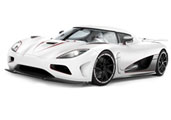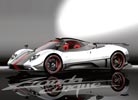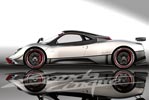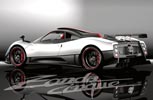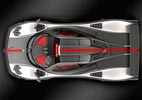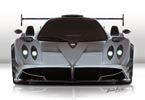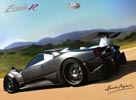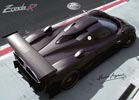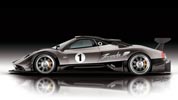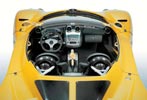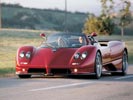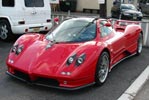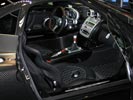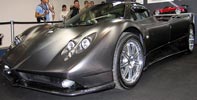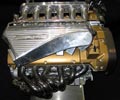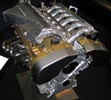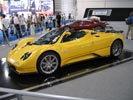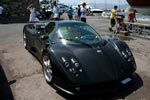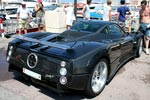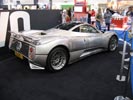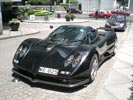The Pagani Zonda is a mid-engined sports car produced by Pagani in Italy. It debuted in 1999 and continues through the present, with production proceeding at roughly 25 cars per year. Construction is mainly of carbon fiber.
Some early Pagani Zonda engineering was done by Formula One champion, Juan Manuel Fangio. The car was originally to be named for him, the "Fangio F1", but the name was changed upon his death in 1995, renamed after an air current above Argentina.
The Pagani Zonda C12 F debuted at the 2005 Geneva Motor Show. It is the most extensive reengineering of the Pagani car yet, though it shares much with its predecessors including the 7.3 L V12. Power is increased to 602 PS (594 hp/443 kW) with a special clubsport model producing 650 PS (641 hp/478 kW). The company promises a 3.5 second sprint to 62 mph (100 km/h), a top speed over 215 mph (346 km/h) and it will be the queen in braking from 300 km/h to 0 (186 mph to 0). The Zonda F clubsport has a power to weight ratio of 528 bhp/ton (384 W/kg). An Enzo Ferrari, comparatively, has a power to weight ratio of 483 bhp/ton (356 W/kg).[citation needed]
The top speed can be further tweaked by adjusting the aerodynamic settings. 215 mph (346 km/h) is the car's top speed on the setting for the best handling which provides the most down force but also has the highest drag coefficient. If the aerodynamic settings were adjusted the top speed would be a bit higher. This also seems to be the reason that when EVO Magazine attempted the Pagani Zonda S's top speed on the Autobahn, that they were only able to get the car to 197 mph (317 km/h), as opposed to its claimed top speed of 220 mph (350 km/h). It would make sense that if the car was set up for maximum downforce then its top speed would drop to around 200 mph (320 km/h). Company representatives at Pagani's factory backed up this claim. However, the EVO article claimed that aerodynamic parts, specifically ones which created drag were in fact removed during the run, bringing Pagani's claims into question.
The Pagani Zonda F Clubsport holds the record for the fastest lap by any production car around the Nürburgring, lapping the 12.9 miles (21 km) Nordschleife in 7 minutes 27.82 seconds, beating the previous record holder, the Porsche Carrera GT.[1]
Production of the Pagani Zonda F will be limited to 25 cars, still not US compatible. The next model (codenamed C9), due to be unveiled in 2009, will be fully EPA/DOT compatible.
The Pagani Zonda F, named after F1 driver Juan Manuel Fangio, comes with an extra head light and different fog lights at the sides, new bodywork (revised front end, new rear spoiler, more aerodynamic vents all around) that improves the cars aerodynamics and different side mirrors. Further enhancements over the 'S' centre around optional carbon/ceramic brakes developed in conjunction with Brembo, magnesium wheels, inconel titanium exhaust system, hydroformed aluminum intake plenum and a redesigned 'Z preg' weave in the crash structure to improve rigidity and reduce weight.
The R Clubsport was debuted at the Geneva Motor Show 2007, still using the 6.0 litre V12 sourced from AMG by Mercedes-Benz.[3] The R Clubsport's competition lies with track-biased cars such as the Ferrari FXX and Maserati MC12 rather than the original Pagani Zonda 's road competitors. It is thought, therefore, that like the FXX and some models of the MC12, the R CS will not be road-homologated. Since it is likely that the car will be ineligible under FIA regulations for almost any form of organized racing, the car is essentially relegated to privateer racing in nonstandard series and the owner's private track time, much like customer versions of the MC12. For comparison the FXX, which has its own race-series, is also neither road nor race homologated, and is not even delivered to the owner, instead being 'made available' by Ferrari at specified events. The Pagani-designed race-models are also far more proven and targeted racecars, so it is unlikely that even heavily-modified R CSs will compete in formal racing.
Despite sharing much of the Pagani Zonda 's shape, the R CS is almost entirely new, sharing only 10% of the Pagani Zonda F's components. It has been obliquely suggested by Horacio Pagani that this car is a testbed chassis for certain components of the Pagani Zonda 's replacement (in the same vein as the Ferrari 288 GTO Evoluzione and the successive F40) and that the R CS accurately reflects some of the Pagani Zonda 's successor's features.
Chassis: The central carbon chassis incorporates a roll cage and a rubber racing fuel cell with 4 fuel pumps and quick refuel filler cap, similar to GT race cars. The wheelbase has been increased by 47 mm (1.9 in) to increase stability. The front and rear subframes are brand-new, built to accommodate new suspension geometry, and produced in Avional. The slick-shod wheels are new forged-magnesium centre-lock models, which in conjunction with on-board pneumatic airjacks (again, like the FXX) allow rapid change of the entire wheel assemblies.
The car senses, displays and logs information about the amount of downforce that is generated at each wheel at all times. It is thought that this system will enable owners to adjust set-up according to track conditions and to improve their cornering technique.
Bodywork: In addition to the wheelbase increase (47 mm), overall length has increased by 394 mm (15.5 in) and track by 50 mm (2 in). The bodywork and aerodynamics have been altered to offer maximum downforce, featuring a longer front bonnet with flaps, a closed underbody and a new rear overhang with adjustable rear wing and race-derived diffuser. These are intended to translate into increased aerodynamic efficiency and downforce for maximum cornering speed. It is also noted that the car's new rear bodywork is minimal in the extreme, being composed mostly of vent. This is thought to be symptomatic of the need to keep the engine cool enough, even under hard track use. Again, this is similar to the gutted bodywork of the Ferrari Evoluzione.
Engine: Output has increased to 750 bhp (559 kW) at 8000 rpm and 523 lb·ft (709 N·m) of torque. A lightweight carbon fibre high performance intake system, racing multiple disc sintered clutch and Formula 1-style exhaust system, hydroformed in Inconel 625 and ceramic coated for optimal heat dissipation, have been added. The engine is combined with a 6-speed transverse-mounted manual sequential synchronized gearbox.
Interior: The car's interior is spartan reflecting the car's racetrack aspirations and intended home, and features bespoke seats, customized to the driver to offer maximum support. As before, the Digitek instrumentation provides essential information and the sophisticated telemetry allows a variety of sensors to monitor numerous aspects of the car.
Cost: The Pagani Zonda R Clubsport, as a final, specialized run-out model, is expected to cost in excess of US$1.2 million.
Car - Pagani Zonda
Copyright © 1998-2013 you.com.au

